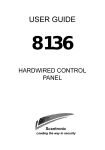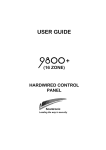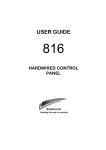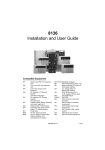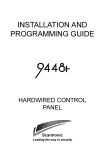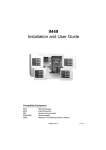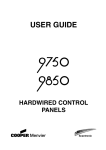Download Scantronic 9800+ User guide
Transcript
9800 Installation and User Guide Compatible Equipment 9825 9827 9040 9056 9076-01/02 960 9066 Remote Keypad Remote Keypad Internal loudspeaker (16 Ohm). 2 max, fit at least one. Plug-on Digital Communicator Signalling Relay Interface Speech/Digital Communicator Self-Activating Bell (SAB) Module 496334 Issue 1 1 of 14 9800 Introduction The 9800 Alarm Control Panel comprises a control unit in a shielded case, and up to four separate keypads. The control unit provides: ° Connections for up to eight Closed Circuit zones. ° Connections for four outputs (external sounder, strobe, and two fully programmable outputs). ° Connections for up to four 9825 Keypads. ° Pins for fitting a plug-on communication device. Any device that complies with the Scantronic plug-on footprint can be fitted. ° Internal sounder loudspeaker output with electronically generated Chime, Alarm and Fire tones. The programming interface is arranged as a set of two-digit numbered commands. The system can provide for up to 4 separate users. User facilities include: ° Three different security levels (full set and two part sets) which can be programmed by the installer. ° User programmable Duress code. ° Keyswitch setting/unsetting. Technical Specifications General Operating temperature Humidity Dimensions Weight Standby Battery = -10 °C to + 40 °C. = Up to 80% non-condensing. = h x w x d 300 x 300 x 75 mm. = 4.85 Kg (excl battery). = 12 Volt, 6.0Ah rechargeable lead-acid, Gel Type battery. Power Supply The total current available from the control unit is as follows: System output current = 800mA (Ambient Temp. 20 °C). Control unit pcb = 60mA quiescent. = 500mA active (when driving standard external bell). Each 9825 Remote Keypad = 20mA quiescent. = 60mA active. 2 of 14 496334 Issue 1 9800 9825 Keypad Addressing Standard 9066 SAB Module Plug-on 9056 Communicator = 40mA. = 40mA. Keypad Wiring Recommended maximum distances for the remote keypads from the control unit, using standard alarm cable is 100 metres for the star configuration. Outputs OP1, OP2, Bell, Strobe = 500mA. Transistorised outputs capable of driving a relay. 9825 Keypad Addressing Before connecting the keypad(s) to the system, the engineer must set the address of each keypad. Each keypad in a system must have a different address number to ensure that the control unit can correctly identify them. To set the address: 1. Ensure the system is powered down. 2. Open the keypad and identify the four position DIP switch on the keypad pcb, see Figure 1 below. Note that each switch is numbered 1 to 4. The numbers correspond to the keypad address. Figure 1. Keypad Address Switch 3. Select one switch and move it to the ON position (up). Make sure all the other switches are OFF (down). The keypad now has the address given by the switch that is ON. Adjusting Keypad Sounder Volume You can alter the volume of the keypad sounder by adjusting the potentiometer located next to the sounder. See Figure 1. When first installing the keypad set the potentiometer midway using a small screwdriver. 496334 Issue 1 3 of 14 9800 Wiring Figure 2 shows the main connector on the control unit PCB. Subsequent sections describe how to wire keypads and closed circuit zones. Figure 2. Main Connector 4 of 14 496334 Issue 1 9800 Wiring Keypads Wiring Keypads All keypads must be connected to Keypad terminals on the control unit PCB or "daisy chained" to other keypads. Figure 3 shows the connections for each keypad using the 9285 as an example: Figure 3. Wiring the 9285 Keypad Note: The output for the lock release interface must be a transistorised type. A recommended type is RS Components 349-254. A SEPARATE 12 Volt DC supply is required. Contact rating is 10 A. Caution: Do not connect other devices (for example SAB, speakers and so on) in the same cable as the remote keypad wiring. 496334 Issue 1 5 of 14 Wiring Keyswitches 9800 Wiring Keyswitches Connect a keyswitch to the I/P and 0V terminals of the nearest keypad (see Figure 4). Make sure you use a two position, unbiased keyswitch. Figure 4. Keyswitch Communications The control unit can be fitted with communicators that conform to the standard Scantronic plug-on communicator footprint (for example, the 9056 and 9058 Plug-on Digital Communicators, a 960 Speech/Digital Communicator, or a Plug-on Red Care Transmitter). For communicators that do not conform the 9076-01 and 9076-02 can be used as interfaces to the system. 6 of 14 496334 Issue 1 9800 Programming Initial Power Up When all wiring is complete, power up the system for the first time as follows: 1. Ensure that the keypad(s) and detectors are securely fitted and their tamper switches closed. 2. Connect the battery and then close the case. 3. Switch on the mains power. Ignore any tones from the internal and keypad sounders. 4. Go to a keypad and key in 1234. 5. Key in 0 followed by 7890 (the default Engineer’s code). The keypad gives an intermittent tone. 6. Open the end station lid. (If the lid is already open, close and open the tamper switch.) The displays shows “E” (engineer). You are now in programming mode. Programming Commands When delivered from the factory the control unit already has default program settings. To change the default programming you must be in programming mode. Then: 1. Key in the appropriate command number. The display shows the current value of the command. 2. Key in digits to select the value you require. The display shows a code giving the new value. 3. Press Clear to store the new value of the command. If at any time you change your mind, repeat step 1 to 3. The table on the following pages shows the commands and their options. ( A y next to a command value shows that it is the factory default.) The factory default access codes are: Engineer Code 7890 Access Code User 1 1234 Access Code 2 to 4 AAAA (inactive) Access Code 3 BBBB (inactive) Access Code 4 CCCC (inactive) Duress Code OMIT, OMIT, OMIT, OMIT (inactive) Note: The factory default Access Codes 02 to 04 and the Duress Code must be changed by USER 1 to a four digit number to activate them. 496334 Issue 1 7 of 14 Engineer Program Commands 9800 Engineer Program Commands To change: Zone n Notes Default n = zone number 01 to 08 x = Zone type, one of: 0 = nu (not used) y 1 = PA (panic alarm) 2 = Fr (fire zone) 3 = Al (normal alarm) 4 = 24 (24 hour zone) 5 = FE (final exit) 6 = ER (entry route) y = Zone attributes, any of: 7 = ch (chime) 8 = St (soak test) 9 = 2A (double knock) B = b (armed in part set B) C = c (armed in part set C) OMIT = OA (omit allow) Example: Zone 3 is a Normal Alarm, active in Part Set B and C, that is Omit Allowed. Type in: 03 Zone Number 3 Normal Alarm B Active in Part Set B C Active in Part Set C OMIT Omit Allow CLEAR to store the value of the command. Output 1 11 x y x = Output Type, one of: 0 = Bell follow 1 = Exit/entry follow 2 = Set latch type 1 Y 3 = Set latch type 2 4 = Shock sensor reset 5 = Walk test 6 = Entry system 7 = 24 hour alarm y = Output state, one of: 8 = positive applied Y 9 = positive removed Output 2 12 x y (as for command 11) 49 Engineer Code 20 nnnn Engineer code 7890 Bell Output Type 21 0 SAB, negative applied in alarm Y 1 SCB, negative removed in alarm Loudspeaker Chime 22 1 Chime through loudspeaker & kypds Y 0 Chime through keypads only RedCare reset † 23 0 Disabled Y 1 Enabled 8 of 14 Key-in: 0n x y 496334 Issue 1 9800 To change: Duress mode Internal Sounder Sounder Delay on Entry PA Response Night Line Fault Response Day Line Fault Response System Reset PA Reset First circuit lockout Entry Abort Day tamper comms † and Engineer on Site Keypad Input Exit Mode Auto Re-Arm Bell Delay Engineer Program Commands Key-in: 24 0 1 25 0 1 26 0 1 30 0 1 31 0 1 32 0 1 33 0 1 34 0 1 35 0 1 36 0 1 37 0 1 38 0 1 2 39 0 1 2 40 0 1 2 3 4 41 0 1 2 3 4 5 6 7 Notes Default Audible Silent Y Follows external bell Y Continuous Normal Delay always Y Audible Y Silent Full alarm No alarm Y Audible Y Silent User reset Y Engineer reset User reset Y Engineer reset Lock out Y Re-arm Disabled Y Enabled (90 seconds abort time) Disable (local audibles only) Y Enabled, communicator channel 5 Exit terminate Y Keyswitch Lockset Timed or terminate set Y Final door set Lock set Never Once Y Twice Three times Always No delay Y 1.5 minutes 3 minutes 5 minutes 10 minutes 15 minutes 20 minutes Infinite delay 496334 Issue 1 9 of 14 Engineer Program Commands 9800 To change: Bell Duration Key-in: Notes Default 42 1 1.5 minutes 2 3 minutes 3 5 minutes 4 10 minutes 5 15 minutes 6 20 minutes Y 7 nil Entry Time 43 1 10 Seconds Y 2 20 seconds 3 30 seconds 4 45 seconds 5 60 seconds 6 120 seconds Exit Time 44 0 Continuous (exit terminate only) 1 10 Seconds Y 2 20 seconds 3 30 seconds 4 45 seconds 5 60 seconds 6 120 seconds CSID Code 50 n...n Seed code for remote reset Available from Jan 1993 on all models. Area B final exit response 60 0 Final exit Y 1 Normal alarm Area B Entry route 61 0 Entry route Y 1 Start entry timer Area B Exit mode 62 0 As full set 1 Quick set (10s) Y 2 Instant set 3 Deferred set Area B Alarm response 63 0 Keypad sounders only 1 Internal and keypad sounders Y 2 All sounders, no comms 3 Full alarm (comms and sounders) Area C final exit 70 see 60 Area C Entry route 71 see 61 Area C Exit mode 72 see 62 Area C Alarm response 73 see 63 Event log 90 1 View earlier events 3 View later events Test External Bells 91 Bell output operates Clear Bell test ends Test Strobe 92 Strobe output operates Clear Strobe test ends Test Internal sounder 93 Internal sounder operates Clear Internal sounder test ends 10 of 14 496334 Issue 1 9800 Leaving Programming Mode To change: Test keypad sounder Test output 1 Test output 2 Walk Test Load defaults Leave programming Key-in: Notes 94 Keypad sounder operates Clear Keypad sounder test ends 95 Programmable output 1 operates Clear Output 1 test ends 96 Programmable output 2 operates Clear Output 2 test ends 97 Zone LED and sounder operate when circuit open Clear End walk test 98 Load defaults 99 Default Leaving Programming Mode When all programming has been completed: 1. Key-in ‘99’ at the keypad. The display clears and the Day LED is ON. The system is now in user mode. Note: If there is a fault on the system , for example an open tamper circuit, the display shows this and will not return to Day mode. Press Y (Clear) and rectify the faults. Engineer Reset To perform an Engineer Reset: 1. Check that the display is showing the alarm condition. (Note: if the display shows “rr”, Press Clear twice.) 2. Key in 0 followed by the Engineer’s code (default 7890), followed by 99. The display goes blank and the Day LED glows. Re-Entering Programming Mode “Initial Power Up” describes how to enter programming mode for the first time in a new installation. If you wish to enter programming mode at any other time: 1. Make sure the system is unset. 2. Press 0, then key in the Engineer’s code (default 7890). The keypad gives an intermittent tone. 3. Open the end station lid. The display shows “E” (for ‘engineer’) and the intermittent tone stops. You are now in programming mode. 496334 Issue 1 11 of 14 Refreshing the NVM 9800 Refreshing the NVM If the user and/or engineer codes are lost, or you want to revert to the factory default programming, then: 1. First remove mains power before opening the case and then disconnecting the battery. 2. Identify and remove the NVM chip (IC4) on the main pcb (see Figure 1). 3. Reconnect the battery, then re-apply mains power. 4. Refit the NVM chip (note the locator marker position, see Figure 1). The end station loads the factory default access codes (User 1: 1234, engineer: 7890). 5. Carry on to re-program the system. Testing You may test parts of the system by entering commands at the keypad. To carry out a test make sure the system is in programming mode and then key in one of the following commands. Press Clear to end each test: 91 To test the external sounder/bell. 92 To test strobe output. 93 To test the internal sounder output. 94 To test the keypad sounder. 95 To test programmable output No. 1. 96 To test programmable output No. 2. 97 To carry out a system walk test. This allows the engineer to test all alarm devices. When a circuit is opened, the internal sounder(s) will emit a tone and the appropriate circuit LED lights. Reading the Log The control unit keeps a 60 event log of recent events. Each event is represented by a two digit code, shown on the next page. To review the event log, make sure the system is in programming mode, then: 1. Key in 90. The display shows the most recent event in the log, for example "c7". For a list of the log codes see the next page. 2. 3. Key in 1 to show earlier events or 3 to see more recent events. Press Clear to leave the log. 12 of 14 496334 Issue 1 9800 Event Log Displays The table below shows all the messages that can appear in the event log. The left hand column shows the codes that appear on a keypad display. Event Log Displays Keypad AA Ab Ac AE AP bF c1 to c8 cc cF E1 to E8 EA EF Lb Lf Lt o1 to o8 PF r1 to r4 rP rr rt S1 to S8 Sr t1 to t8 tr u1 to u9 Meaning Arm area A (full set) Arm area B (part set) Arm area C (part set) Installer access Auxiliary power failure Battery fault Zone violation Communication successful Communications failure Entry via zone circuit Entry alarm Exit fault Low battery Telephone line failure End station lid tamper Zone omitted Mains power failure Remote keypad back tamper Remote keypad missing Installer reset required Remote keypad excess key presses tamper Zone soak Test System reset (total power failure) Zone tamper violation Tamper return fault Access user (u5 = Duress, u9 = keyswitch) 496334 Issue 1 13 of 14 9800 User Commands Set/Unset System User code + A Part Set User code + B or C Omit zone (1-8) User code + A, B or C + OMIT + Zone number Omit 24 hour zone User code + OMIT + Zone number Reinstate omitted 24 hour zone User code + OMIT + CLEAR Change User code User code + 4 + old code + new code + CLEAR Read Log User code + 5 + 1 to see earlier events or 3 to see later events + CLEAR + CLEAR Chime On/Off User code + 7 + CLEAR Bell Test User code + 8 + CLEAR to end test Walk Test User code + 9 + CLEAR to end test Note: Duress code default is OMIT OMIT OMIT OMIT and is inactive until changed. 14 of 14 496334 Issue 1














